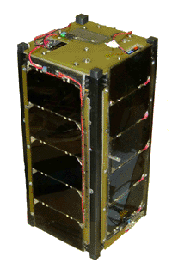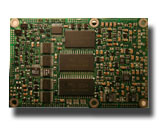We have an interesting project for any teacher or independent student who is interested in a fun project. We offer the Paper CubeSat project. Basically, the paper CubeSat is a folded sheet of paper in the shape of our satellite, a box. Each face has a profile of the satellite, giving it a "real" CubeSat appearance. The paper CubeSat can be attached to a balloon and students can have their own launch of their own CubeSat. Inspire your kids or yourself into the exciting world of engineering. Paper CubeSat: Paper_Cubesat-ION.doc Directions: Paper_CubeSat_Directions.doc
What is CubeSat?
The CubeSat project is a student designed and built satellite that is able to work in space. It's not as big as you would picture a normal satellite. Our CubeSat is only 10cm long, 10cm wide and 20cm high. There are many computer chips and sensors inside the satellite to help us do the tasks of the satellite project.
What are we planning on doing in Space? Our first plan is to test new pieces of satellite technology, proving that they can work in space. Our second plan is looking at gases in our upper atmosphere. This will help scientists better understand how our planets environment is changing.
The satellite was completed by April 2005. It was, then, sent to a University in California for more testing and then our CubeSat, along with 11 other CubeSats from other schools, was shipped to Russia. There, it was placed on a rocket and then launched into space. The interesting thing about these Russian rockets is that they actually use to be nuclear warhead rockets, basically atom bombs. They removed the warhead from the tip of the rocket and placed the satellites there in its place.
How long did it take to build the Satellite? It took over 100 student engineers almost four years to design, build and test the satellite. All of these engineers didn't work on the project all at once, though. Because we are in a university, we had to continually train new junior engineers to replace the senior engineers who graduated from the school.
What's going to happen to it in Space?
|
|||||||||||


 What's
your progress with finishing the Project?
What's
your progress with finishing the Project? We
hope the satellite will survive in space for six months to a year, but we don't
exactly know how long the satellite will last in space. It can stop working
right when it gets up there or it can stop working years from now. There isn't
an exact way to know. But we are expecting it to work for six months to a year.
Then, it will short out and stop working. The reason why this happens is because
the sun sends a lot of charged particles throughout our solar system. When they
collect on our satellite, they cause short circuits to happen, possibly burning
out our computer chips. After the satellite stops working, it will remain in
orbit for nine more years. After that, the satellite will get so close to earth,
it will completely burn up in atmosphere.
We
hope the satellite will survive in space for six months to a year, but we don't
exactly know how long the satellite will last in space. It can stop working
right when it gets up there or it can stop working years from now. There isn't
an exact way to know. But we are expecting it to work for six months to a year.
Then, it will short out and stop working. The reason why this happens is because
the sun sends a lot of charged particles throughout our solar system. When they
collect on our satellite, they cause short circuits to happen, possibly burning
out our computer chips. After the satellite stops working, it will remain in
orbit for nine more years. After that, the satellite will get so close to earth,
it will completely burn up in atmosphere.